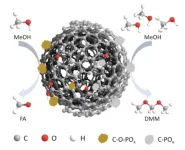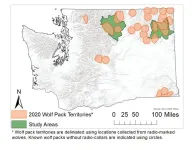(Press-News.org) PHILADELPHIA— To make someone put their phone down while driving, show them the money—with a catch, according to new research published in JAMA Open. When a group of auto insurance customers were tempted with a cash incentive—and regular feedback letting the driver know how they were doing compared to other drivers trying to reduce their phone time—handheld phone use dropped significantly, a team at the Perelman School of Medicine at the University of Pennsylvania found.
The researchers examined several different strategies informed by behavior science to curb distracted driving in a seven-week trial. One strategy paired weekly feedback on phone use with a cash incentive of up to $50 at the end of the study if the drivers used their phones less than others. That approach yielded a 15 percent decrease in handheld phone usage compared to drivers given no incentive or feedback. However, when drivers were told that they would receive the same amount of money paid out in weekly installments, but lose it if they engaged in handheld phone usage while driving, phone use decreased by 21 percent.
“In the United States, there are over 800,000 crashes per year due to distracted driving, with cell phone use while driving being a leading cause. This occurs despite numerous laws banning handheld phone use, suggesting additional scalable interventions are needed,” said lead author M. Kit Delgado, MD, MS, faculty director of Penn Medicine’s Nudge Unit and an associate professor of Emergency Medicine and Epidemiology. “We were able to use the power of humans’ natural aversion to loss and regret, as well as our desire to fit in to social norms, to achieve some significant results.”
Insurance companies saw a 30 percent climb in distracted driving-related crashes between 2011 and 2020, largely tied to cell phone usage. Twenty-eight states have passed bans of handheld phone usage while driving, with Pennsylvania the latest state to enact a law, , which takes effect mid-2025.
The practice of incentivizing drivers’ behaviors is rising. Auto insurance companies are increasing “usage-based insurance (UBI)” where customers agree to download smartphone apps to monitor driving performance and cell phone usage. The data is then used to adjust rates for individual drivers, with safer drivers being offered discounts on future insurance policies.
For the study, Penn Medicine researchers worked with researchers at Progressive Insurance®, which invited customers participating in their own UBI program to participate, enrolling over 2,000 participants in the study.
With deidentified data, Penn Medicine’s researchers determined that a group of drivers who were told (and updated weekly) that they could lose up to $7.15 a week were the ones who used their phones least compared to the control group of drivers that had no incentives or feedback. Interestingly, doubling the incentive to $14.29 per week didn’t lead to a greater reduction in phone use, though there was a significant decline. There were also notable results among drivers who received feedback and were offered the $50 incentive at the end of the test period.
Drivers offered the delayed $50 incentive at the end of the intervention but received no weekly feedback and no incremental loss for weekly performance did not achieve significant results.
The reason why feedback and loss-framed payments appeared to be so critical, Delgado believes, is innately human.
“People tend to think they are better drivers than others,” he said. “Providing objective data on how they compare to others is a proven way to motivate people toward a social norm. Also, prior studies have shown that those who engage in handheld phone use tend to have ‘present bias’ and place stronger weight on payoffs that are closer to the present time.”
When broken down into time, the top achieving intervention—the $7.15-per-week group—lowered their phone usage by an average of 56 seconds per hour down from a baseline of 216 seconds per hour. When taking one's eyes off the road for 5 seconds increases the risk of crash ninefold, at scale, these interventions could reduce distracted driving by millions of hours per year.
This work continues research performed by Delgado into distracted driving dating back to 2016 (which led to a 2018 paper) and continues with further nudge data analysis. Future research includes testing interventions leveraging smartphone usage data that could help high-risk drivers build lasting habits.
“This line of work is promising because insurance companies already spend billions of dollars per year offering incentives for safe driving behaviors,” said Delgado. “Rigorously testing strategies these companies can use to engage customers to be safer can help reduce crashes, save lives, and save money, and, importantly, be sustained through a strong business case.”
This current study was funded by the Federal Highway Administration Exploratory Advanced Research Program, the National Institutes of Health (K23HD090272001), Progressive Casualty Insurance Company, and an Abramson Family Foundation philanthropic grant.
Editor’s note: Some of the study co-authors not affiliated with Penn Medicine work for Progressive or worked for Cambridge Mobile Telematics, a company contracted by Progressive.
END
When there’s money to lose, phone usage while driving drops
2024-07-10
ELSE PRESS RELEASES FROM THIS DATE:
Astronomers find missing link in massive black hole formation
2024-07-10
Omega Centauri is a spectacular collection of 10 million stars, visible as a smudge in the night sky from Southern latitudes. Through a small telescope, it looks no different from other so-called globular clusters; a spherical stellar collection so dense towards the center that it becomes impossible to distinguish individual stars. But a new study, led by researchers from the University of Utah and the Max Planck Institute for Astronomy, confirms what astronomers had argued about for over a decade: Omega Centauri contains a central black hole. The black hole appears to be the missing link between its stellar ...
Researchers build first-ever molecular atlas of blood vessel pathways in the human brain, across early brain development, adulthood and disease
2024-07-10
An international consortium of researchers led by University Health Network (UHN) in Toronto and University of Zurich have built the first-ever molecular atlas of the human brain vasculature at single-cell resolution, spanning from early development to adulthood and through disease stages such as brain tumours and brain vascular malformations.
The international consortium includes research teams from UHN’s Krembil Brain Institute, Donald K. Johnson Eye Institute, Toronto General Hospital Research Institute and Princess Margaret Cancer Centre, the University of Toronto’s Donnelly Centre, Mount Sinai Hospital’s Lunenfeld-Tanenbaum ...
Antiferromagnetic phase transition observed in fermionic Hubbard quantum simulator
2024-07-10
In a study published online in Nature, a research team led by Prof. PAN Jianwei, Prof. CHEN Yuao, and Prof. YAO Xingcan from the University of Science and Technology of China (USTC) of the Chinese Academy of Sciences has, for the first time, observed the antiferromagnetic phase transition within a large-scale quantum simulator of the fermionic Hubbard model (FHM). This study highlights the advantages of quantum simulation. It marks an important first step towards obtaining the low-temperature phase diagram of the FHM and understanding the role of quantum magnetism in the mechanism of high-temperature ...
A drug that lowers blood lipids could help treat the world’s most common liver disease
2024-07-10
The University of Barcelona has led a study that suggests using the drug known as pemafibrate to treat liver disease associated with metabolic disorders, the most common liver pathology in the world, which affects one in four people. The drug has long been marketed in Japan for another use: improving blood lipid levels in patients with hyperlipidaemia, a common condition in diabetics. Now, however, it could help address this serious liver disease, which still has no specific treatment.
The study, carried out on laboratory animal models and published in the journal Biomedicine & Pharmacotherapy, was conducted by a team led by Professor Juan ...
Ochsner, AJMC® partner for conference on value-based care on July 25 in New Orleans
2024-07-10
NEW ORLEANS – Ochsner Health’s Healthy State initiative, in partnership with The American Journal of Managed Care, will host a free conference on value-based care from 3:30-7 p.m. on Thursday, July 25 at The Westin New Orleans hotel in Louisiana.
Registration and program details are available here for “Healthy State: Know It, Own It, Live It: Creating a Thriving Louisiana Through Innovation in Value-Based Care.” The event is open to the public, medical professionals, health policy experts and community organizers.
Organized ...
NIH funds consortium to accelerate development of new TB treatments
2024-07-10
A new consortium co-led by Weill Cornell Medicine, has been awarded a five-year, $31 million grant from the National Institutes of Health’s National Institute of Allergy and Infectious Diseases to accelerate the development of faster, more effective treatment regimens for tuberculosis (TB). Investigators at the University of California, San Francisco; Johns Hopkins Medicine; and Vanderbilt University Medical Center comprise the other co-leads.
The Preclinical Design and Clinical Translation ...
Older women more likely to receive heart surgery, die at low quality hospitals
2024-07-10
Women over the age of 65 who require complex heart surgery are more likely than men to receive care at low quality hospitals — where they also die in greater numbers following the procedure, a Michigan Medicine study finds.
The research, published in JAMA Network Open, covered nearly 450,000 Medicare beneficiaries who underwent coronary artery bypass grafting, or heart bypass surgery, between late 2015 and early 2020.
Compared to men, women were 1.26 times more likely to be treated at low quality hospitals, meaning facilities with the highest 30-day mortality rates.
At those low quality hospitals, ...
Nanocarbon catalyst design unlocks new avenue for sustainable fuel additive production
2024-07-10
Vehicle exhaust from fossil fuel combustion constitutes a main source of air pollutants like carbon dioxide and carbon monoxide. To mitigate air pollution, researchers are looking into additive to fuels like dimethoxymethane (DMM). But DMM production brings its own environmental hazards.
In their paper published June 21 in Carbon Future, a Chinese research team demonstrated how a series of phosphorous-modified nanocarbon catalysts could advance green DMM production.
Unique fuel properties of this diesel blend fuel include high oxygen content and chemical stability as well as low toxicity. A blend of DMM and ...
Wolves’ return has had only small impact on deer populations in NE Washington, study shows
2024-07-10
FROM: James Urton
(Note: researcher contact information at the end)
Humans drove wolves to extinction in Washington state around the 1930s. Thanks to conservation efforts, by about 80 years later, wolves had returned — crossing first from the Canadian border into Washington around 2008 and later entering the state from Idaho. Since then, wolf numbers in Washington have been steadily growing, raising questions about what the return of this large predator species means for ecosystems and people alike.
In northeast Washington, where wolves have recovered most successfully, researchers from the University of Washington and the Washington Department ...
Producing ‘space brick’ for moon base using microwave
2024-07-10
The Moon’s recent discovery of energy resources, such as water ice, has refocused interest on its potential as a sustainable hub for space exploration. NASA has also announced the Artemis mission, aiming for long-term human presence on the lunar surface. However, infrastructure expansion, such as lunar base construction plays a vital role.
Yet, transporting construction materials from Earth to the lunar surface via landers incurs a significant cost of 1.2 million USD per kilogram. Weight directly translates to cost, making the transportation of construction materials from Earth to the Moon nearly impossible.
To solve this problem, Korea ...





